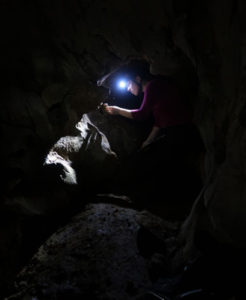
A Griffith University PhD candidate is the first to use a novel virtual method to examine fossil-bearing deposits in Sumatran cave sites to form a chronology of fossil burial and cave formation.

Published in Scientific Reports for a special edition entitled Quaternary Taphonomy, PhD candidate Holly Smith from the examined three different cave sites on the Indonesian island of Sumatra using rapid thermal neutron tomographic imaging to determine the composition of breccia and fossil distributions within.
The study disproves previous hypotheses that fossil remains entered the caves as one rapid debris flow, and instead are a result of multiple deposits laid down by water and gravity flow over a prolonged period.
The sites – Ngalau Gupin, Ngalau Sampit and Lida Ajer – in the Padang Highlands of western Sumatra, contained a diverse range of vertebrate fossils dating around 70,000 years old that were buried in ancient sediments.
The results suggest that the timelines of both human and animal arrivals, migrations, settlements, and extinction patterns previously formed by dating the cave fossils could be inaccurate, as natural mixing processes may have occurred during this more complex depositional history.
Thus, several different ecosystems separated by tens of thousands of years may appear to have co-existed.
Traditional methods of fossil excavation from cave breccia (broken rock fragments cemented by a fine-grained sediment) and subsequent preparation risks damage to the specimens and can destroy contextual evidence in the surrounding sediments.
Previous studies had mainly been restricted to observations as to surface colour and composition of the breccia while the researcher was in the cave, which obscured and disregarded a vast amount of important information.

Neutron tomographic imaging had previously been considered expensive and time-consuming, but the method is becoming increasingly affordable and obtainable for scientific research.
This method had not been used earlier as tropical cave breccia were too dense for traditional CT imaging to penetrate, and it was considered that the internal characteristics of the deposits could not be observed. Neutrons can, however, pass through these samples much more easily and allow for the virtual reconstruction of the breccia interior.
“This is the first time that neutron tomography has been used to conduct a survey of geological samples to extract prehistoric data,” Ms Smith said.
Neutron imaging is a relatively new method in palaeontology and is used here to reveal the sediments that form tropical cave breccia and fossils (and the interrelationships between both) within.
The novel creation of rapid neutron imaging by Holly’s colleague and co-author, Dr Joseph Bevitt, at the Australian Nuclear Science and Technology Organisation in Sydney, is much faster than previous neutron studies and incurs less residual radioactivity, so samples are ready more quickly for further analysis.

“The results of this study reveal new evidence as to the dominant factors responsible for the accumulation and preservation of cave fossil remains. It may refine our understanding of the timing and modification of tropical cave fossil accumulations and thus improve the accuracy of the historical record of biodiversity, climate, and environmental changes in Southeast Asia,” Ms Smith said.
“These data suggest the original theories of site formation have previously been oversimplified. This neutron study proves the mixing and modifying processes in the Sumatran caves are significant and may have serious implications on the validity of fossil dating in the region.
“Rapid thermal neutron tomography may develop into a key conventional method to study fossil and sediment evidence preserved in tropical cave breccia and inform the validity of previous timelines established in the region.
“I hope this neutron imaging study could be replicated, and integrated with further new methods, to form detailed histories of life, death and burial of ancient fauna preserved in tropical caves.”
The research ‘High-resolution rapid thermal neutron tomographic imaging of fossiliferous cave breccias from Sumatra’ has been published in Scientific Reports for a special edition entitled Quaternary Taphonomy.





